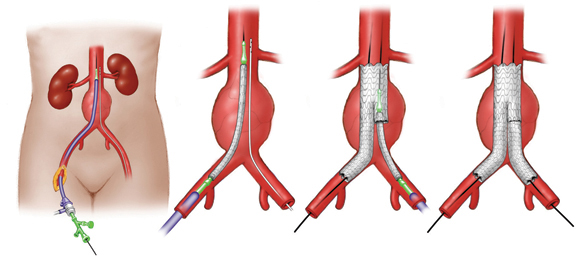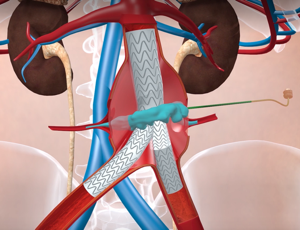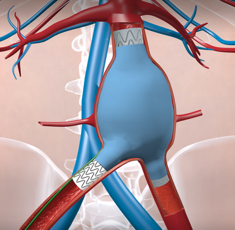In vitro and in vivo characterization of injectable in situ curing polymer and interaction with stent grafts used for aortic aneurysm treatment
PROJECT ACRONYM
2ACP
FUNDED BY
Health~Holland
PHD CANDIDATE
J.R. (Jeffrey) Nagel, MSc.
SUPERVISORS
prof. dr. M.M.P.J. (Michel) Reijnen
prof. dr. M. (Michel) Versluis
dr. E. (Erik) Groot Jebbink
COLLABORATION
TripleMed B.V.
CLINICAL BACKGROUND
An abdominal aortic aneurysm (AAA) is a widening of the aorta due to a weakened vessel wall, which is most prevalent in older men. If the aneurysm continues to grow in diameter, it can rupture and lead to death. The favored treatment method in current clinical practice is endovascular aneurysm repair (EVAR), where an endovascular stent graft is placed at the aneurysm location through a minimally invasive surgical procedure (see figure 1). The stent graft guides the blood flow and in doing so relieves pressure from the weakened aortic wall.

Figure 1. Schematic representation of endovascular aneurysm repair (EVAR) procedure. Image from: https://treatmyaneurysm.com/aneurysm/aaa
EVAR shows better short-term results than open surgery, due to the decreased risk of perioperative complications and subsequent lower 30-day mortality rate. However, possible mid- to long-term complications result in the need for frequent monitoring and more reinterventions. These complications are mainly endoleaks (68% of all complications), stent occlusion (12%) and stent migration (12%). Endoleak is a persistent blood flow within the aneurysm, which can result in continued growth of the aneurysm diameter. Most common is type II endoleak, where the persistent blood flow results from a collateral vessel on the aortic wall, such as the lumbar arteries. To reduce the number of reinterventions, the use of a stent graft can be combined with a polymer injection to seal endoleaks and stabilize the stent graft (see figure 2). However, there is little fundamental knowledge available to support this innovative combination of stent graft and polymer injection.


Figure 2. Injection of the TripleMed polymer to locally seal endoleaks (left) or for prophylactic filling of the whole aneurysm sac (right). Images adapted from: http://www.triplemedical.com/aneufix and http://www.triplemedical.com/aneufill
OBJECTIVE
An innovative combination of an EVAR graft and a polymer injection could be used for treatment and prevention of endoleaks, while also providing stability to the stent graft. The aim of this project is to provide knowledge about application of the silicone-based curing polymer developed by TripleMed. The project will include extensive in vitro testing of the polymer visibility with fluoroscopy and CT, its dynamic behavior during the injection phase and the interaction of the cured polymer with the stent graft and aortic wall.
PROJECT DETAILS
Characterization of polymer visibility on fluoroscopy and CT images
Status: ongoing
The polymer injection is used to seal endoleaks, but if the polymer overshoots in the lumbar arteries, this can lead to severe complications. It is therefore crucial that the polymer is sufficiently visible for safe and controlled injection. On the other hand, if the polymer visibility is too high, this will result in significant scattering on CT scans. To ensure safe and controlled injection, while also minimizing scattering on CT scans, the visibility of the polymer needs to be optimized.
Development of a realistic, average model of the abdominal aortic aneurysm
Status: ongoing
To facilitate the in vitro work in this project, a realistic phantom of the abdominal aortic aneurysm is required. Such phantoms are typically either (over)simplified or patient-specific. We are developing a realistic, average AAA model based on a large patient cohort. The phantoms that are fabricated in this project will be based on this model.
Investigation of the dynamic behavior of the polymer during the injection phase.
Status: ongoing (early stages)
The polymer is injected in a dynamic environment and its behavior can be significantly influenced by various flow parameters, such as the flow velocity and the pulsatile nature of the blood flow. The behavior of the polymer during injection will be investigated for various realistic flow environments.
Quantification of polymer-stent graft motion using dynamic CT scans
Status: planned (Q1 2022)
Stent grafts are specifically designed and tested for safe application in the aorta. However, a polymer-stent graft combination could have different mechanical properties for which the stent graft was not designed. The motion of the stent graft with and without the applied polymer will be quantified using dynamic CT scans. This way, the mechanical interaction of the polymer and the stent graft can be investigated.
PUBLICATIONS
-
